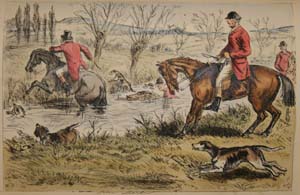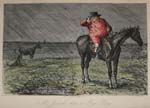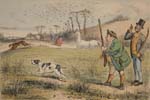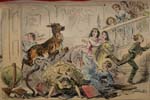Sporting Books

Hunting, angling (fishing), and outdoor adventure books have always been popular in Britain, and the Regency and Victorian periods were no exception. While illustrations for these books contain elements of caricature, they are distinctly their own genre, and include a large amount of images of animals in addition to people.

In 1838 Robert Surtees published a collection of his magazine articles featuring Mr. Jorrocks, the "jolly, free-and-easy, fox-hunting grocer" (Surtees's own description), under the title of Jorrocks's Jaunts and Jollities. Jorrocks was to become his best comic creation and feature in a number of his later works. Jorrocks's Jaunts and Jollities was illustrated by Henry Alken, the dominant sporting artist of the nineteenth century. Alken was from a family of engravers and painters. In addition to book illustration, he published many individual sporting prints, the first appearing in 1813, and also wrote several books on engraving.

This is a longer, more rounded Jorrocks novel, Surtees's second, with illustrations by the caricaturist John Leech. Jorrocks, as drawn by Leech, became an instantly recognizable character. Leech's model for Jorrocks was a coachman whom he had surreptitiously sketched from a neighboring pew during a church service. Leech was an avid angler, hunter, and sportsman, so it is not a surprise that his illustrations for Surtees's sporting books were so successful. Surtees himself was an active landowner, an agricultural reformer, and a conscientious magistrate and poor-law guardian, all of which probably influenced his writing. He wrote anonymously, although he never troubled to conceal his authorship.

Surtees's first moderate success was Mr. Sponge's Sporting Tour, another sporting novel. Although he hunted all his life, he was not a good horseman. And although his work was popular in some circles, others were offended by his morality: his male characters were coarse or shady; his leading ladies dashing but not virtuous; his outlook on society satiric to the point of cynicism. Leech's softer, less scathing style of caricature and drawing may have helped to mitigate these perceptions.

This was Surtees's last book, published posthumously in 1865. Surtees regarded it as a sequel to Mr. Sponge's Sporting Tour and some critics consider it his best novel. Surtees died before the novel was published, and Leech, who was illustrating it, died while the novel was being serialized, without completing the plates for the final chapters of the book. His place was taken by Hablot K. Brown, also known as Phiz, who is most well-known as the illustrator of many of Charles Dickens's novels.
